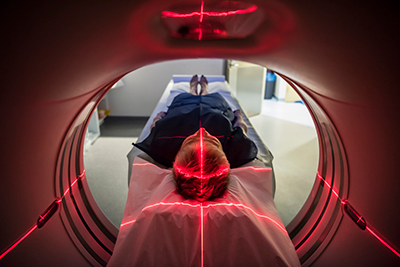Researcher Investigates Brain Neurocircuits to Better Understand Mental Illness

Amit Etkin, M.D., Ph.D., sees a gathering wave that will transform how mental illness is perceived, identified, treated, and monitored in the coming years.
“We are not there yet, but we are getting close to the transition point to a circuits-based understanding of mental illness,” said Etkin at APA’s Annual Meeting. Etkin is an associate professor of psychiatry and behavioral sciences at Stanford University.
The transition from DSM-IV to DSM-5 was significant, but “we are still in the dark ages” of psychiatric diagnosis, he said. Both the DSM series and the National Institute of Mental Health’s Research Domain Criteria (RDoC) are constructed from the literature, observation, and consensus. The DSM was predicated on the idea that “if we build stronger correlations, we will find causation. But that is not so. We have to separate correlation from causation.”
These are among the questions that Etkin and his fellow researchers want to know: What are the circuit characteristics of psychiatric disorders? What “rules” govern treatment response? Will understanding causal mechanisms drive new treatments?
“We’ve created an unwarranted specificity” with existing DSM definitions, he said. “The way we’ve studied mental illness has influenced how we’ve defined mental illness.”
In his studies of patients with posttraumatic stress disorder (PTSD), for instance, Etkin has looked for patterns that might predict response to prolonged exposure therapy. Combining a visual memory recall task with functional MRI (fMRI) revealed that a greater response in the prefrontal brain region predicted better treatment outcomes, independent of symptoms. Then he used a verbal memory test with two sets of patients with PTSD, each subdivided into impaired and intact groups.
Connectivity in the salience network was similar in the intact patients and the healthy controls but significantly lower in patients impaired by PTSD, said Etkin. Thus, using an objective test separated patients who were equally symptomatic into two cohorts based on brain signatures tied to their behavior rather than on symptoms or diagnosis.
Meta-analyses of imaging studies of emotional processing in thousands of patients with anxiety and depression indicate many commonalities across existing diagnoses, like loss of volume in gray matter networks. The biggest difference was between patients with and without psychosis, he said.
Sham-controlled repetitive transcranial magnetic stimulation (rTMS) significantly increased global connectivity and reduced amygdala activity in patients with major depression. Lower baseline connectivity predicted better post-treatment results, as measured by changes in Hamilton Depression Rating Scale (HAM-D) score.
While fMRI is too expensive for the clinic, it is an extremely useful research tool. In contrast, electroencephalogram (EEG) machines are both more common and more affordable. Etkin discussed ways of using EEG with a protocol called “power envelope” to study the visual, somatomotor, frontoparietal regions of the brain, as well as the default mode network. Within two to three years, he plans to recruit PTSD patients based on biology, not symptoms, and then assess them weekly to develop metrics on brain function.
The move toward a circuits-based psychiatry may still be a work in progress, but progress is moving rapidly, he believes.
“We can transform psychiatry by identifying points of neural circuit dysfunction in individuals, then achieve optimized neural circuit plasticity, and use our toolbox to restore neural circuit function to improve behavioral symptoms,” he said.
(Image: iStock/JohnnyGreig)
|
|
|
|
Advertisement
 |
|
 |
|
|

